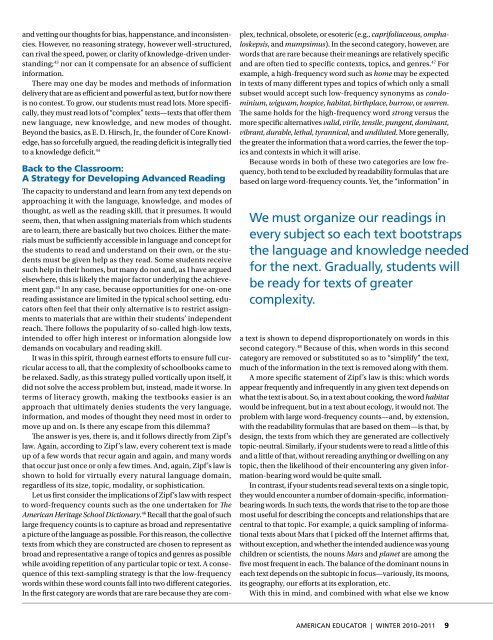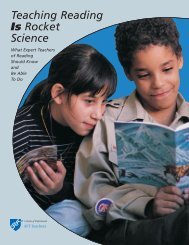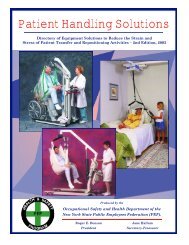American Educator, Winter 2010-11, Vol. 34, No. 4, AFT
American Educator, Winter 2010-11, Vol. 34, No. 4, AFT
American Educator, Winter 2010-11, Vol. 34, No. 4, AFT
You also want an ePaper? Increase the reach of your titles
YUMPU automatically turns print PDFs into web optimized ePapers that Google loves.
and vetting our thoughts for bias, happenstance, and inconsistencies.<br />
However, no reasoning strategy, however well-structured,<br />
can rival the speed, power, or clarity of knowledge-driven understanding;<br />
43 nor can it compensate for an absence of sufficient<br />
information.<br />
There may one day be modes and methods of information<br />
delivery that are as efficient and powerful as text, but for now there<br />
is no contest. To grow, our students must read lots. More specifically,<br />
they must read lots of “complex” texts—texts that offer them<br />
new language, new knowledge, and new modes of thought.<br />
Beyond the basics, as E. D. Hirsch, Jr., the founder of Core Knowledge,<br />
has so forcefully argued, the reading deficit is integrally tied<br />
to a knowledge deficit. 44<br />
Back to the Classroom:<br />
A Strategy for Developing Advanced Reading<br />
The capacity to understand and learn from any text depends on<br />
approaching it with the language, knowledge, and modes of<br />
thought, as well as the reading skill, that it presumes. It would<br />
seem, then, that when assigning materials from which students<br />
are to learn, there are basically but two choices. Either the materials<br />
must be sufficiently accessible in language and concept for<br />
the students to read and understand on their own, or the students<br />
must be given help as they read. Some students receive<br />
such help in their homes, but many do not and, as I have argued<br />
elsewhere, this is likely the major factor underlying the achievement<br />
gap. 45 In any case, because opportunities for one-on-one<br />
reading assistance are limited in the typical school setting, educators<br />
often feel that their only alternative is to restrict assignments<br />
to materials that are within their students’ independent<br />
reach. There follows the popularity of so-called high-low texts,<br />
intended to offer high interest or information alongside low<br />
demands on vocabulary and reading skill.<br />
It was in this spirit, through earnest efforts to ensure full curricular<br />
access to all, that the complexity of schoolbooks came to<br />
be relaxed. Sadly, as this strategy pulled vortically upon itself, it<br />
did not solve the access problem but, instead, made it worse. In<br />
terms of literacy growth, making the textbooks easier is an<br />
approach that ultimately denies students the very language,<br />
information, and modes of thought they need most in order to<br />
move up and on. Is there any escape from this dilemma?<br />
The answer is yes, there is, and it follows directly from Zipf’s<br />
law. Again, according to Zipf’s law, every coherent text is made<br />
up of a few words that recur again and again, and many words<br />
that occur just once or only a few times. And, again, Zipf’s law is<br />
shown to hold for virtually every natural language domain,<br />
regardless of its size, topic, modality, or sophistication.<br />
Let us first consider the implications of Zipf’s law with respect<br />
to word-frequency counts such as the one undertaken for The<br />
<strong>American</strong> Heritage School Dictionary. 46 Recall that the goal of such<br />
large frequency counts is to capture as broad and representative<br />
a picture of the language as possible. For this reason, the collective<br />
texts from which they are constructed are chosen to represent as<br />
broad and representative a range of topics and genres as possible<br />
while avoiding repetition of any particular topic or text. A consequence<br />
of this text-sampling strategy is that the low-frequency<br />
words within these word counts fall into two different categories.<br />
In the first category are words that are rare because they are com-<br />
plex, technical, obsolete, or esoteric (e.g., caprifoliaceous, omphaloskepsis,<br />
and mumpsimus). In the second category, however, are<br />
words that are rare because their meanings are relatively specific<br />
and are often tied to specific contexts, topics, and genres. 47 For<br />
example, a high-frequency word such as home may be expected<br />
in texts of many different types and topics of which only a small<br />
subset would accept such low-frequency synonyms as condominium,<br />
wigwam, hospice, habitat, birthplace, burrow, or warren.<br />
The same holds for the high-frequency word strong versus the<br />
more specific alternatives valid, virile, tensile, pungent, dominant,<br />
vibrant, durable, lethal, tyrannical, and undiluted. More generally,<br />
the greater the information that a word carries, the fewer the topics<br />
and contexts in which it will arise.<br />
Because words in both of these two categories are low frequency,<br />
both tend to be excluded by readability formulas that are<br />
based on large word-frequency counts. Yet, the “information” in<br />
We must organize our readings in<br />
every subject so each text bootstraps<br />
the language and knowledge needed<br />
for the next. Gradually, students will<br />
be ready for texts of greater<br />
complexity.<br />
a text is shown to depend disproportionately on words in this<br />
second category. 48 Because of this, when words in this second<br />
category are removed or substituted so as to “simplify” the text,<br />
much of the information in the text is removed along with them.<br />
A more specific statement of Zipf’s law is this: which words<br />
appear frequently and infrequently in any given text depends on<br />
what the text is about. So, in a text about cooking, the word habitat<br />
would be infrequent, but in a text about ecology, it would not. The<br />
problem with large word-frequency counts—and, by extension,<br />
with the readability formulas that are based on them—is that, by<br />
design, the texts from which they are generated are collectively<br />
topic-neutral. Similarly, if your students were to read a little of this<br />
and a little of that, without rereading anything or dwelling on any<br />
topic, then the likelihood of their encountering any given information-bearing<br />
word would be quite small.<br />
In contrast, if your students read several texts on a single topic,<br />
they would encounter a number of domain-specific, informationbearing<br />
words. In such texts, the words that rise to the top are those<br />
most useful for describing the concepts and relationships that are<br />
central to that topic. For example, a quick sampling of informational<br />
texts about Mars that I picked off the Internet affirms that,<br />
without exception, and whether the intended audience was young<br />
children or scientists, the nouns Mars and planet are among the<br />
five most frequent in each. The balance of the dominant nouns in<br />
each text depends on the subtopic in focus—variously, its moons,<br />
its geography, our efforts at its exploration, etc.<br />
With this in mind, and combined with what else we know<br />
AMERICAN EDUCATOR | WINTER <strong>2010</strong>–20<strong>11</strong> 9





